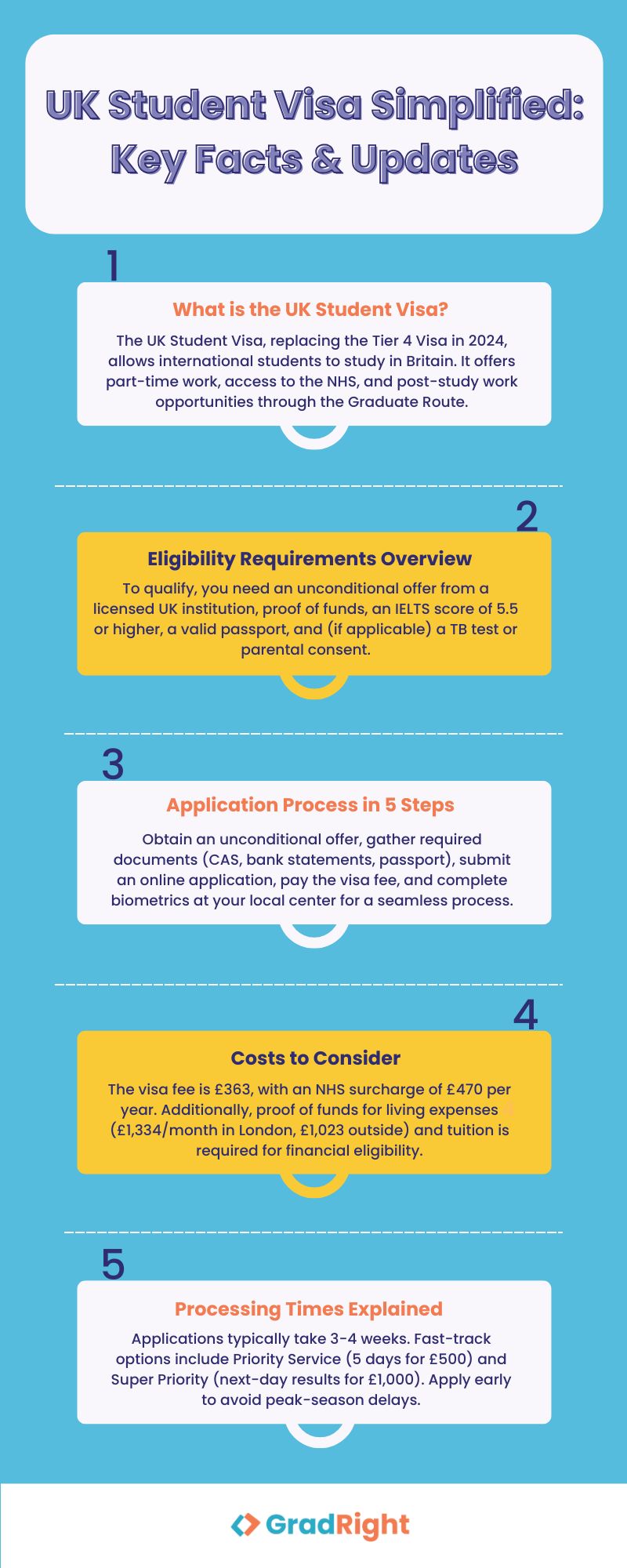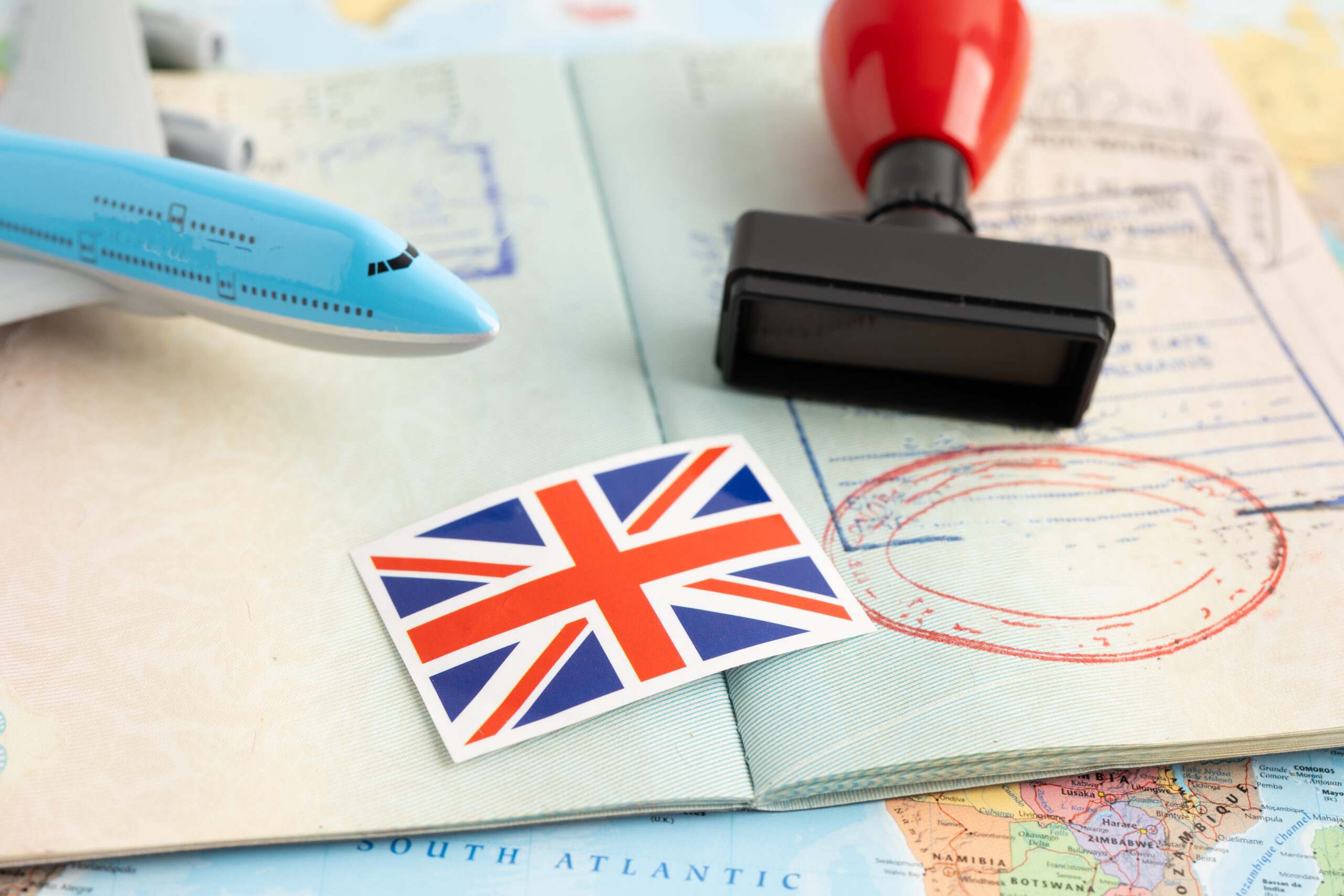Tier 4 Student Visa UK: Requirements, Eligibility, Cost, Processing Time
We’ve got important updates about the UK tier 4 visa that you need to know.
As of early 2024, the T-4 visa has been replaced.
Now, to turn your dream of studying in Britain into reality, you must first understand the UK tier 4 visa plus its replacement.
Naturally, it was a very roundabout process to apply for and receive a UK tier 4 visa, and the same is true of the new visa.
But that’s what we are here to break down.
So without any further ado, let’s get right into it.

What is a Tier 4 student visa in the UK?
The UK tier 4 visa, also called the “UK student visa” was the main route for international students to come and study in the UK. It was aimed at people from outside the EEA (European Economic Alliance) and Switzerland.
This category of visa lets these students come to the UK for either higher education or high school education. You could get the UK tier 4 visa if you were enrolling at any of the schools on the approved list, which were called “licensed sponsors”. It used to have a 450 GBP fee and was valid for one year.
The UK tier 4 visa even lets you bring dependents to the UK, depending on the programme that you were enrolled in.
These were the main features of the UK tier 4 visa:
- It gave you permission to study at a licensed UK educational institution.
- You had the ability to work part-time during term (up to 20 hours per week) and full-time during holidays.
- You also had the option to bring dependents (spouse/partner and children) for certain postgraduate courses.
- It was valid for the full length of the course, plus an additional work period after course completion.
- It needed a Confirmation of Acceptance for Studies (CAS) from a licensed sponsor.
- You also needed proof of sufficient funds to cover tuition fees and living costs.
- There was an English language proficiency requirement.
- It included your health surcharge payment for access to the National Health Service (NHS).
- For many people, it was a potential pathway to post-study work opportunities in the UK.
However, the UK government concluded that people misusing the visa and that it was due for an overhaul anyway as it was outdated.
So, the UK tier 4 visa has been replaced by the new “Student visa” route as of January 1, 2024.
The new system is like the tier 4 student visa that it replaces but with some changes. For instance, it has a lot of digitisation and some major restrictions.
Key changes to the new UK student visa include these:
- Most students pursuing non-research postgraduate courses can no longer bring dependents to the UK. Exceptions apply only to government-sponsored students, those enrolled in full-time postgraduate research courses (like PhDs), and students on courses longer than six months with full government scholarships.
- Students must demonstrate they have enough funds to cover their course fees and living costs for up to nine months (or the length of their course if shorter). Currently, this is about 1,400 GBP x the number of months in your course.
- The English language requirements have been standardised across all student categories.
- There are no time limits on the total period a student can study in the UK on a student visa. This is usually four years before a change of visa or a renewal of your visa application will be needed.
- Following successful completion of their course, students may be eligible for the Graduate route. This lets them work or look for work in the UK for two years (three years for doctoral students) post their graduation.
Remember, while the name has changed, the fundamental purpose remains: enabling international study in the UK.
And now, you know what the UK tier 4 visa was, and what the new UK student visa is.
In the next section, we’ll cover the eligibility criteria you need to meet, in order to be given a UK student visa.
Eligibility criteria for Tier 4 student visas
Since the UK tier 4 visa has been replaced by the new UK student visa route, we’ll talk about the new eligibility requirements as well.
Anyway, first, here is a comparison of the old UK tier 4 visa system versus the new one:
| Criteria | Old UK TIER 4 VISA | New UK STUDENT VISA |
| Dependent rights | Most postgraduate students could bring dependents | Only PhD students and government-sponsored students can bring dependents |
| English language | IELTS 5.5 for degree level | IELTS 5.5 for degree level (unchanged) |
| Financial requirements | Proof of funds for 9 months | Proof of funds for 9 months (unchanged) |
| Study time limit | No overall time limit | Maximum of 5 years for degree-level studies |
| Work rights | 20 hours/week during term, full-time during holidays | 20 hours/week during term, full-time during holidays (unchanged) |
| Visa duration | Course length + 4 months | Course length + 2 months for courses less than 12 months, + 4 months for longer courses |
Now that you’ve understood that, let’s take a closer look at the new UK student visa system. One side benefit of the new system is that it is supposed to improve the processing time for a UK student visa, which used to be problematic earlier.
- You must have an unconditional offer from a UK educational institution that holds a valid sponsor licence.
- You need to prove your English skills, usually through an approved test like IELTS. It’s typically IELTS 5.5 for degree-level studies
- You must show you have enough money to pay for your course and support yourself. This usually means having funds to cover your first year’s tuition fees plus £1,334 per month for living costs in London (or £1,023 outside London) for up to 9 months
- You need to prove you’re a genuine student who intends to study in the UK and leave after your course ends
- You must meet the academic requirements set by your chosen institution
- You must be at least 16 years old to apply for a UK STUDENT VISA
- If you’re from a country where TB is common, you might need to take a TB test
- If you’re under 18, you’ll need written consent from your parents or legal guardian
And that’s it — a fairly straightforward process and simple UK student visa rules. In the next part of this guide, we’ll teach you how to apply for one under the new system.
How to apply for a UK student visa?
Here is the UK visa process, as per the UK Visas and Immigration office, also known as UKVI:
- Get an unconditional offer from a UK educational institution that is a licensed sponsor.
- Next, get the needed papers, which include your CAS, bank statements (stamped), and your passport. Note: CAS = Confirmation of Acceptance for Studies.
- Fill out the online application on the official UK government visa website.
- Pay the visa application fee (about 350 GBP) and the Immigration Health Surcharge (about 480 GBP).
- Book a biometric appointment to provide your fingerprints and photographs. You can usually do this at the British Embassy, VFS Global, or High Commission. There will be no UK embassy fees, but VFS Global may levy a charge.
- Attend the appointment, and assuming all else goes well, wait for the application to be processed.
- Under the new system, the UK visas & immigration office says it could take up to 4 weeks.
And that wraps up the section on how to apply for a UK visa online. In the next section, we’ll tell you about UK visa costs.
Cost of the new tier 4 UK Student Visa
The old visa was priced at 348 GBP for students who were not inside the UK at the time of application. The new rules have changed the pricing though.
Under the new system, the cost is made up of two parts; the actual application fee (363 GBP) and the NHS surcharge (470 GBP). Please make a note that the NHS surcharge is for each year of your course. So if the course is three years long, you’ll be paying 470 x 3 = 1410 GBP plus GBP 363 for the application.
Also, remember that these costs are always subject to change. That’s why it’s a good idea to check only the official UK government for the most updated costs.
And, something that people tend to neglect — the proof of funds requirement. Many students often don’t factor this into their visa costs. It is vital to include these as part of your overall expenses.
If you are studying in London, then your visa cost will be:
- Visa application fee: £363
- NHS (for a 3-year course): £1,410 (£470 x 3)
- Proof of finance: £1,334 per month for 9 months (£12,006) + first year’s tuition fees
- Total: £13,779 + first year’s tuition fees
And if studying in the Fringe or outside London, then your visa cost will be
- Visa application fee: £363
- NHS (for a 3-year course): £1,410 (£470 x 3)
- Proof of finance: £1,023 per month for 9 months (£9,207) + first year’s tuition fees
- Total: £10,980 + first year’s tuition fees
And that ends the section on international UK student visa fees. In our last section, we’ll talk about the duration of the application process for the “new” UK tier 4 visa.
How long does it take to get a Tier 4 UK visa?
The old UK tier 4 visa took anywhere from 6 to eight weeks to be processed.
The new one is slightly quicker, at about 3 to 4 weeks. The caveat though, is that these times are for applications made from outside the UK. If your application was made from inside the UK, you’d be looking at about eight weeks of processing time, assuming no delays.
Also, if you start your application (from inside the UK or out) in the peak season of July to September, expect a few delays.
If you are pressed for time, however, UKVI offers two fast-track approaches called “priority service” and “super priority service”.
Regular priority service for your new UK tier 4 visa will get your application processed in 5 working days for a fee of 500 GBP. Super priority service will give you an answer by the next working day, for 1,000 GBP extra. However please note that super priority service is not offered to all countries.
Remember these four things when applying for your new UK tier 4 visa:
- You can apply up to 6 months before your course starts
- If you’re inside the UK, apply at least 2 months before your current visa expires
- Don’t wait until the last minute during peak season (July-September)
- Allow extra time for document preparation, because the embassy can reach out to request additional information
Once you finish applying, you will be allowed to track your application progress. The three main ways of doing that are through the online portal, through email updates, and SMS updates if you choose that option.
Your UK student visa processing time might be longer if:
- Documents are missing
- Further checks are needed
- Applying during peak season
- Political, Military, Emergency or other external factors affect services
- Your country has specific requirements
Don’t book non-refundable travel until you receive your visa. While most applications are processed within standard timeframes, some cases may take longer. Always plan ahead and apply early to avoid any last-minute stress.
And with that, we come to the end of this guide. We hope you found it useful.
Frequently Asked Questions
1. How long does a UK Tier 4 visa take?
The processing time for the Tier 4 visa was typically around 6 weeks if you applied from outside the UK. Under the new Student Route visa, the timeline remains the same.
2. How long does a UK Student visa take?
The UK Student Visa typically takes about 3 weeks to process if you’re applying from outside the UK. However, processing times may vary depending on individual circumstances.
3. How long can I stay in the UK after my Tier 4 visa expires?
You must leave the UK before your visa expires. There is no grace period. If you wish to stay longer, you must apply for a new visa, such as the Graduate Route, before your current visa ends.
4. How much bank balance is required for a UK student visa?
You need to show you have enough money to pay for your first year’s tuition fees plus £1,334 per month for living costs in London (or £1,023 outside London) for up to 9 months.















